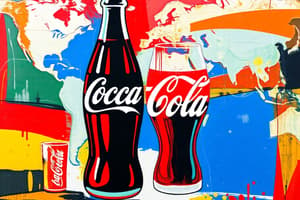Podcast
Questions and Answers
What is a key aspect of the Country of Origin Effect?
What is a key aspect of the Country of Origin Effect?
- Consumers' perceptions about a country extend to products and brands from that country. (correct)
- Products are perceived as of lower quality if manufactured in a different country.
- Only the country of manufacturing affects consumer perception.
- The country of design has no influence on consumer attraction.
According to Giorgio Armani, what does being copied imply?
According to Giorgio Armani, what does being copied imply?
- You are not doing anything.
- You are doing the wrong thing.
- You are doing the right thing. (correct)
- You are unsure what to do.
Which of the following is NOT a characteristic commonly associated with products from Germany?
Which of the following is NOT a characteristic commonly associated with products from Germany?
- Reliable
- Stylish (correct)
- Innovative
- Good quality
What role does consumer expertise play in the Country of Origin Effect?
What role does consumer expertise play in the Country of Origin Effect?
Which of the following groups is more likely to be influenced by the Country of Origin Effect?
Which of the following groups is more likely to be influenced by the Country of Origin Effect?
What do consumers tend to prefer when it comes to products?
What do consumers tend to prefer when it comes to products?
What is an example of a product element that can be protected as part of a brand franchise?
What is an example of a product element that can be protected as part of a brand franchise?
Why do consumers use the origin of a product as a cue?
Why do consumers use the origin of a product as a cue?
What is NOT a factor that influences the Country of Origin Effect?
What is NOT a factor that influences the Country of Origin Effect?
Which of the following countries is commonly associated with 'good technology / innovative' products?
Which of the following countries is commonly associated with 'good technology / innovative' products?
Flashcards are hidden until you start studying
Study Notes
Adaptation
- Mandatory Adaptation: Adapting products to local requirements to legally and physically operate in respective countries (e.g., left-hand driving in the UK, 220V appliances in Europe).
- Non-Mandatory Adaptation: Adapting products to better meet local market needs or developing new brands for individual markets (e.g., McDonald's selling vegetarian burgers in India).
Global Marketing Programmes
- Product Policy Decisions: Deciding on new products for specific markets, adding/removing/modifying products, brand names, packaging, and servicing.
- Marketing Programme Standardization: Standardizing marketing processes and programmes across countries.
Standardization
- Refers to the standardization of decision-making processes for cross-country marketing planning.
- Involves rationalizing general marketing processes, such as launching new products and marketing controlling activities.
Standardization of Marketing Programmes
- Refers to the unification of individual marketing mix elements (4Ps/7Ps) for different national markets.
- Includes standardizing product characteristics, pricing, promotional strategies, and distribution channels.
Product Classification
- Consumer Goods: Products for personal or household use.
- Industrial Goods: Products for business or commercial use.
Product Levels
- Three levels of a product:
- Core Product: Functional features, performance, and perceived value.
- Actual Product: Brand, quality, design, packaging, price, and country of origin.
- Support Services: Delivery, installation, guarantees, after-sales service, and spare parts.
Product Name Characteristics
- Should suggest product features and benefits.
- Easy to pronounce, recognize, and remember.
- Distinctive and capable of registration and legal protection.
- Translates easily and accurately into other major languages.
Product/Brand Name Changes
- Fade-in/Fade-out Strategy: Gradually introducing a global brand name alongside an existing local brand name.
- Transparent Forewarning: Alerting consumers about a brand name change through communication programs, in-store displays, and product packaging.
- Summary Axing: Immediately replacing an old brand name with a new global name.
Protecting Product/Brand Names
- Vulnerable to piracy, including brand name, logo, design, and package.
- Paris Convention for the Protection of Intellectual Property aims to protect brand franchises.
- Differences in opinion between industrialized and developing countries on intellectual property.
Country of Origin Effect
- Perceptions about countries extend to products and brands known to originate in those countries.
- Examples: Germany (good quality/reliable), France (premium/stylish), Italy (good design/cool), and Japan (good technology/innovative).
Country-of-Origin Influences on Consumers
- "Made in" label matters to consumers, especially for domestic products over imports.
- COO influences consumer attraction, particularly for the elderly, less educated, and politically conservative.
- Cultural orientation and consumer expertise also play a role in COO effects.
- COO effects vary depending on product category.
Studying That Suits You
Use AI to generate personalized quizzes and flashcards to suit your learning preferences.




